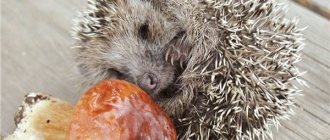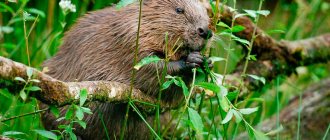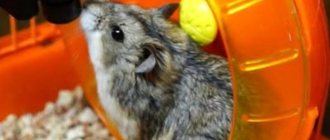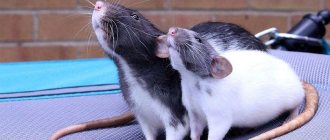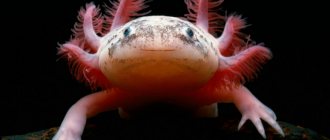- home
- Kinds
31.03.2018
A small, nimble, cheerful and active creature is a representative of the dwarf rodent species Campbell's hamster. This baby will bring his owners a lot of joy, he is unpretentious in daily maintenance and does not require special care. However, some rules of keeping and feeding will have to be strictly followed.
Description of the breed
The Campbell's hamster is a small, agile animal that reaches a length of no more than 10.5 cm and weighs about 25 g. The head is small, round, the muzzle is pointed, the tail is short, thick hair covers not only the body, but also the soles of the paws. Wild animals are gray in color with a brownish tint, with a dark contrasting stripe running down the back. Hamsters living in captivity can vary in color from white to black. There are glands on the abdomen that animals use to mark their territory. In the corners of the mouth there are also special glands that perform several functions:
- - support immunity;
- - promotes better digestion;
- - help to mark food supplies.
For a long time it was believed that this is a subspecies of the Djungarian hamster, but since 1974 these animals have been classified as different species. Outwardly they are very similar, but there are also noticeable differences. Campbell has the following features:
- - there is no dark spot on the head,
- - the stripe on the back is clearly defined,
- - the villi located on the abdomen are colored gray at the base;
- - smaller ears;
- - does not hibernate in winter.
Appearance of Campbell's hamster
Campbell's hamsters come in one color or a variety of colors. The most common color is agouti. Take a look at this photo:
Agouti, it’s something like this (Altai type)
The coat is predominantly sandy-gray in color, the tummy is similar to the color of milk. There are animals of a monochromatic sand color. These dogs do not have a dark stripe on the back, but there are white spots throughout the fur and a light chin. This color is very popular among breeders and lovers of this breed. It's called "self".
Interesting fact : by color you can determine in which region a hamster lives.
The color of the Campbell breed hamster living in the Altai region has more gray color (see photo above), while those living in the steppes of Mongolia have more brown color with a yellowish tint. Here, for example, is a photo of a Mongolian Campbell:
Campbell's Mongolian hamster
Where there is more sand and earth, that is, the soil is brown, in the course of evolution, brownish-colored animals more often survived, since they merged with the earth. It was harder to notice them. They gave brown offspring. In Altai there are more stones and rocks, that is, more gray colors, which is why gray animals predominate there.
In addition to color, there are differences in size, ear shape, head shape and even smell. Significant differences in character. This is due to natural enemies found in the natural habitat of Campbell hamsters. For example, it is believed that animals from the Altai region are less aggressive in nature than their Mongolian counterparts.
Housing preparation
It is recommended to buy a spacious cage, the width of which is at least 60 cm and the length of 40 cm. But these are the minimum dimensions; in a larger cage, the hamster will have more room to run around. It is better to choose models with horizontal metal rods, the distance between which should be small so that the miniature hamster does not crawl out.
You definitely need to put a small house in the cage so that the animal can rest there and also store its supplies. It is better to buy a ready-made house at a pet store, but you can make it yourself from some wooden or cardboard box; a ceramic bowl with a broken edge is also suitable, but the edge should not be sharp so that the pet does not get injured. The cardboard box will have to be changed from time to time, as the hamster will chew holes in it. To prevent the hamster from getting bored, it is advisable to place a running wheel, various ladders and shelves in the cage.
Sawdust or a special filler, which is sold in a pet store, should be poured into the bottom of the cage. Paper napkins are also placed in the cage so that the pet can build a nest for itself. It is not advisable to put fabric scraps, straw and newspaper, since harmful printing ink is applied to the newspaper, and the hamster can become entangled in threads and straw.
A heavy container is selected for food so that the animal does not turn it over. Water poured into a saucer quickly spills and becomes dirty, so it is better to purchase a special drinking bowl that is attached to the wall of the cage and does not spill.
When the home is fully equipped, you can go for the hamster. To transport it, use a small cage 15 cm wide and 10 cm high. The size of the cells should not exceed 1.5 cm. This cage will be useful in the future if you need to take your pet to a veterinary clinic. As a last resort, you can transport the hamster in a box made of thick cardboard with small holes, but only if the journey is not too long (no more than 90 minutes), otherwise the animal will gnaw through the wall and crawl out. If the transportation will last more than three hours, then you need to put a small slice of bread or apple in the cage so that the hamster can eat.
Three rules for choosing a hamster
Rule 1 . It is better to buy a pet at a pet store or from specialists who professionally breed hamsters.
Rule 2 . You need to choose healthy animals. The well-being of a pet can be judged by several signs:
- - smooth, silky and thick coat without bald spots or bald spots;
- - moderate fatness;
- - when breathing, the animal should not wheeze, cough or sniffle;
- - ears, eyes and nose are clean without any discharge or crusts;
- - the hair near the tail is free of dirt.
Rule 3 . It is advisable to purchase young hamsters that are at least three and no more than seven weeks old. At this age, they already eat themselves and are quite independent. The issue of pair housing at home is controversial. Many believe that it is still better to keep them alone to avoid clashes and uncontrolled reproduction, since frequent childbirth weakens the female, and the babies can be born weak and sickly. But if you decide to keep a couple of pets at home, then it is better to purchase them at the same time, since at a young age they get used to each other better, and adult animals can start violent fights.
Links[edit]
- ^ab Cassola, F. (2016). Phodopus campbelli
(revised version published 2022). IUCN Red List of Threatened Species. DOI: 10.2305/IUCN.UK.2016-3.RLTS.T17035A22354039.en - ^ abc Wilson, Delaware; Reader, D.M., ed. (2005). Mammal Species of the World: A Taxonomic and Geographical Guide (3rd ed.). Johns Hopkins University Press. item 1045. ISBN 978-0-8018-8221-0. OCLC 62265494.
- ^ abcd Oldfield, Thomas (1905). "New Cricetulus from Mongolia". Journal of Natural History
.
15
(87): 322–323. DOI: 10.1080/03745480509443049. - ^ abcd Hollister, Ned (1912). "New mammals of the Siberian highlands". 60
(14). Smithsonian Institution: 1–6. Retrieved April 8, 2012. Quote journal requires |journal=(help) - ^ abcde Allen, Glover M. (1938). Mammals of China and Mongolia. New York: American Museum of Natural History. pp. 1, 729. DOI: 10.5962/bhl.title.12195. OCLC 766997.
- ↑
Campbell, C. W. (2000).
Travels through Mongolia, 1902 - Travels of C. W. Campbell, British Consul in China
. Office. ISBN 978-0-1170-2452-6. - Sokolov, V.E.; Vasilyeva N.Yu.; A.V. Surov (1988). "Age and sex characteristics of the functional activity of the sternum in the striped hairy hamster." Reports of the USSR Academy of Sciences
: 438–440. - ^ a b Wynne-Edwards, Kentucky; Terranova, P.F.; Leask, R. D. (1987). "Cycling Djungarian hamsters, Phodopus campbelli
, do not have the progesterone surge typically associated with ovulation and behavioral receptivity."
Endocrinology
.
120
(4):1308–16. DOI: 10.1210/endo-120-4-1308. PMID 3830052. - ^ab Gudermuth, D; Butler, W. R.; Johnston, R. E. (1992). "Social influences on reproductive development and fertility of female Djungarian hamsters ( Phodopus campbelli
)".
Hormones and behavior
.
26
(3): 308–29. DOI: 10.1016/0018-506X(92)90002-D. PMID 1398551. S2CID 26371122. - Jump up
↑ Nagy, F (1990).
"On the ultrastructure of the male reproductive tract of the Siberian hamster." Journal of Submicroscopic Cytology and Pathology
.
22
(4): 615–625. PMID 2282646. - Sokolov, V.E.; N. Yu. Vasilyeva (1991). "Additional pouches at the entrance to the cheek pouches of the Campbell's hamster." Reports of the USSR Academy of Sciences
: 102–106. - ^ abc Weiner, January; Heldmeier, Gerhard (1987). “Metabolism and thermoregulation in two races of Djungarian hamsters: Phodopus sungorus sungorus
and
P. s.
Campbelli ".
Comparative Biochemistry and Physiology
.
86
(4): 639–42. DOI: 10.1016/0300-9629 (87) 90615-3. PMID 2882893. - Vanderlip, Sharon (2009). Dwarf hamsters
. Barrons. pp. 60–61. ISBN 978-0-7641-4096-9. - Doty, R.L.; D. Mütze-Schwarze (1992). Chemical signals in vertebrates
. New York: Plenum Press. item 637. ISBN. 978-1-4757-9655-1. - ^ abc Vorontsov N.N. Rajabli S.I.; Lyapunova K.L. (1967). "Karyological differentiation of allopatric forms of the supraspecific
hamster
Phodpus sungorus
and heteromorphism of sex chromosomes in females."
Reports of the USSR Academy of Sciences
.
172
(3):703–735. PMID 5590132. - Ryan, James (1986). "Comparative morphology and evolution of cheek pouches in rodents". Journal of Morphology
.
190
(1):27–42. DOI: 10.1002/jmor.1051900104. PMID 3783717. S2CID 32865142. - ^ a b Ross, Patricia D.; Cameron, Duncan M. (1989). "Comparison of the physical development and ontogeny of behavior of the Djungarian hamster and the desert hamster". Acta Theriologica
.
34
: 253–68. DOI: 10.4098/AT.arch.89-27. - Herberg, L.; K.D. Buchanan; L. M. Herbertz; H. F. Kern; H. K. Kley (1980). "The Djungarian hamster, a laboratory animal with inappropriate hyperglycemia." Comparative Biochemistry and Physiology
.
65
(1): 35–60. DOI: 10.1016/0300-9629 (80) 90383-7. - Voss, Karinm; Herberg, Liselotte; Kern, Horstf (1978). "Fine structural studies of the islets of Langerhans in the Djungarian hamster (Phodopus sungorus)". Cellular and tissue research
.
191
(2):333–42. DOI: 10.1007/BF00222428. PMID 354796. S2CID 20520796. - ^ ab Pogosianz, H. E. (1975). "The Djungarian hamster is a suitable tool for oncological and cytogenetic research." Journal of the National Cancer Institute
.
54
(3): 659–64. DOI: 10.1093/JNCI/54.3.659. PMID 1123853. - Jump up
↑ Wynne-Edwards, K. E. (1992).
"Field studies of chemical signaling: direct observations of dwarf hamsters in Soviet Asia". Chemical Signals in Vertebrates VI
. pp. 485–491. DOI: 10.1007/978-1-4757-9655-1_74. ISBN 978-1-4757-9657-5. - Jump up
↑ Hamann, U. (1987).
"Zu Aktivität und Verhalten von drei Taxa der Zwerghamster der Gattung Phodopus
Miller."
Zeitschrift für Säugetierkunde
(in German): 65–76. - ^ a b c d e Richardson, V. G. C. (2003). "Systems and diseases." Diseases of small domestic rodents. pp. 127–31. DOI: 10.1002/9780470690840.ch14. ISBN 978-0-470-69084-0.
- Gad, Shane S., ed. (2007). Animal models in toxicology
(2nd ed.). CRC Press. item 248. - ^ abc Grzimek, Bernhard, ed. (1972). Grzimek's Encyclopedia of Animal Life: Vol. 13
. New York, NY: Van Nostrand Reinhold Co., p. 306. - Richardson, V. G. C. (2003). "Animal Husbandry and Nutrition". Diseases of small domestic rodents. Malden, MA: Blackwell Publishing. pp. 138 -9. DOI: 10.1002/9780470690840.ch15. ISBN 978-0-470-69084-0.
- ^ abcdefg Flint, Vladimir (1966). Die Zwerghamster der paläarktischen Fauna (in German). Ziemsen. paragraph 97. Retrieved April 16, 2012.
- ^ a b Jordan J. (1971). "Establishment of a colony of Djungarian hamsters (Phodopus sungorus) in the United Kingdom". Journal of the Institute of Animal Science
.
22
(2): 56–60. Archived from the original on June 13, 2022. Retrieved August 3, 2012. - “Toxic food for hamsters; grapes and raisins." Hammy's World Syrian Hamster Breeders. Retrieved February 5, 2012.
- ^ab Flint, W.J.; N. Golovkin (1961). "Comparative study of the ecology of hamsters in the Tuva region." Bulletin of the Moscow Society of Testers of Priody, Biological Branch
: 57–76. - Nekepilov, N. W. (1960). "Transbaikal dwarf hamsters and some ecological features of the subfamily of dwarf hamsters." News of the Irkutsk Research Institute
. Anti-plague Institute of Siberia and the Far East. - ^ a b c d e Meyer, Minnesota (1967). "Features of reproduction and development of Phodopus sungorus
in different geographical populations."
Zoological Journal
.
46
: 604–614. - "Campbell's Russian Dwarf Hamsters: Breeding". CampbellsDwarfHamsters.com. Retrieved August 6, 2012.
- ↑ Dwarf hamster: Guide to selection, maintenance, care, nutrition, behavior, health, reproduction, types and colors
. Books of the Kingdom. 2003. pp. 67–71. ISBN 978-1-85279-210-7. - Brekke, T.D.; J. M. Good (2014). "Growth effects of parental origin and the evolution of hybrid invulnerability in dwarf hamsters". Evolution
.
68
(11):3134–3148. DOI: 10.1111/evo.12500. PMC 4437546. PMID 25130206. - Safronova, LD; Vasilyeva N.Yu. (1996). “Meiotic abnormalities in interspecific hybrids of Phodopus sungorus
(Pallas, 1773) and
Ph.
Campbelli (Thomas, 1905)".
Rus. J. Genet
.
32
: 486–494. - Sokolov, V.E.; Vasilyeva N.Yu. (1993). "Hybridological analysis confirms the species independence of Phodopus sungorus
(Pallas, 1773) and
Phodopus campbelli
(Thomas, 1905)."
Dokl. Ross. Academician Sci
.
332
: 120–123. - Veselovsky, Z.; S. Grundova (1964). Beitrag zur Kenntnis des Dschungar-Hamsters (PDF) (in German). pp. 305–311.
- Yudin, B.S.; L.I. Galkina; A.F. Potapkina (1979). Mammals of the Altai-Sayan Mountain Region
. The science . paragraph 296. - Loukashkin, A. S. (1940). "On the pikas of Northern Manchuria." Journal of Mammology
.
21
(4): 402–404. DOI: 10.2307/1374875. JSTOR 1374875. - Thomas, Oldfield (1908). "The Duke of Bedford's Zoological Research in East Asia. — IX. List of mammals from the Mongolian Plateau". Proceedings of the Zoological Society of London
.
78
(1): 104–110. DOI: 10.1111/j.1096-3642.1908.tb01837.x. - ↑
Borsa, Carmen. "Vulpes corsac". University of Michigan Museum of Zoology. Retrieved May 5, 2012. - Brom, I. P. (1952). "Diet of desert arctic foxes in Transbaikalia." Lime of the Irkutsk Research Institute
. Anti-plague Institute of Siberia and the Far East. - Lipaev, W.M.; P.P. Tarrasov (1952). “Information on the diets of birds of prey in Southwestern Transbaikalia.” News of the Irkutsk Scientific Research Institute
.
Institute of antipests for Siberian and fern Osten. 10
. - ↑
Peshkov, MG (1957).
"Diets of Djungarian and Daurian dwarf hamsters." Irkutsk Research Institute
.
Antirest Institute. 23
.
Lifestyle
In the wild, Campbell's hamsters usually live in small groups. There is a leader in the group, he dominates the others and demands unquestioning obedience. If a skirmish occurs, the ordinary hamster stands on its hind legs in front of the leader, demonstrating obedience.
They live in shallow burrows. For relaxation, a cozy nesting chamber is set up, which is lined with dry leaves and grass. There is also a pantry where grains and seeds are stored. Several exits break out of the hole at once, so that you can hide in case of danger.
In the evening, hamsters usually leave their burrows and go out in search of food. The menu consists of both plant and animal foods. The animals feast on the seeds and berries of various plants, and also catch small insects and larvae.
In winter, they do not hibernate, but hide in burrows and eat supplies from the pantry. The Campbell's hamster does not exhibit torpor in case of hypothermia, which is observed in other types of hamsters.
What to feed Campbell?
Hamsters are not picky eaters. They readily eat wheat, peas, oats, lentils, corn, and sunflower seeds. It is better to give a mixture of grains so that the diet is varied and balanced. It is convenient to purchase ready-made mixtures for hamsters at a pet store, since the seeds in them are selected in the right ratio and enriched with vitamins. Ready-made food mixtures are sold not only in the usual bulk, packed in a box, but also in the form of sticks that can be hung from the top wall of the cage. This food is convenient because it does not crumble along the bottom of the cage, and the animal is interested in gnawing the grains gradually.
A necessary component of the diet is fresh vegetables and fruits . You can give carrots, zucchini, pumpkin, cucumber, beets, apples, bananas, grapes, watermelon, raspberries, peach, strawberries, raisins.
It is useful to include fresh dandelion leaves, clover, lettuce, as well as parsley and dill in the menu. Animals will also be happy with sprouted wheat, which contains many substances that are beneficial to the pet’s health. You can put dry wheat ears and small cherry, birch and apple twigs in the cage. Clover and dandelion leaves should be plucked from areas where lawns have not been treated with chemicals.
Since in nature animals eat not only plant foods, but also animals, the menu at home needs to be supplemented with protein animal foods. Pets are offered boiled chicken meat, fish, liver; you need to choose low-fat pieces and do not salt them during cooking. It is also recommended to give milk, low-fat varieties of cheese and cottage cheese, and yogurt. You can give milk oatmeal or semolina porridge, but not more than twice a week.
It is necessary that the cage contains a special mineral stone, which consists of salt and chalk, which are important for the health of the hamster. In winter, when there is little fresh food, the animals are given vitamins, which are sold in pet stores. To ensure that vitamins get into your pet’s body, the tablets can be crushed and sprinkled with the crumbs on the food.
Hamsters usually drink little, but fresh water must be in the cage. Do not pour tap water into the drinking bowl. You need to take clean filtered or boiled water, which it is advisable to change at least every two days.
A healthy, active animal eats approximately 5 times a day. There is no need to give too much food, especially for fatty foods - sunflower seeds, cheese, meat, cottage cheese. You also need to remove excess food in a timely manner, otherwise it will spoil and the hamster may get poisoned.
There are a number of foods that should not be given to your hamster, otherwise it will have digestive problems. You need to exclude cabbage, onions, citrus fruits, almonds, pine nuts, tomatoes, persimmons, kiwi, peanuts, and garlic from your diet. You should also not give chocolate, sweets and all salty, sweet, fried and smoked foods.
Breed diseases
Campbells are vulnerable to various infectious diseases. It is a rare hamster that has never had a cold in its life. It is not recommended to treat your pet yourself. At the first signs of illness, it is better to take the animal to the veterinarian. In addition to colds, hamsters often suffer from tumors. To save the poor people from such diseases, they just need to get rid of chips, crackers and other similar products. Rodents are also prone to polycystic disease (infertility) and diabetes - melon, watermelon and other sweet fruits are prohibited.
Melon and watermelon seeds can be given in small quantities. There are a lot of useful things in them.
Reproduction
The breeding season for Campbell's hamsters usually lasts from spring to early autumn. During these few months, the female can give birth to cubs several times. But this is undesirable for pets, as it weakens the female. To get healthy offspring, hamsters must be at least three months old and no more than a year old, they must be active and healthy.
If the hamsters previously lived separately, then they need to get used to each other. A metal mesh partition should be placed in the cage and the hamsters should be placed on opposite sides. This way they can get to know each other, smell each other, but will not fight. When the animals get used to each other, the partition can be removed.
Later, the male will need to be separated from the pregnant female. During this period, the female needs a more nutritious diet; it is recommended to give her more protein foods - boiled chicken, cheese, cottage cheese, milk.
Pregnancy lasts from two to three weeks. You need to put things in order in the cage in advance and change the filling so that after birth you do not disturb the female and the cubs. Perhaps you need to buy a new, larger house so that the family does not feel crowded, or put out a cardboard box with paper napkins.
After giving birth, you should not disturb hamsters, and you should also not pick up the babies, otherwise the female will smell a different smell and may abandon the babies.
Usually between 2 and 12 cubs are born. They are born blind and bald, but with small teeth. On the 5th day, their fur grows, and their eyes usually open on the 10-15th day, at the same time the hamsters begin to feed on their own. The cubs grow very quickly, and when they are three weeks old, they can already be placed in a separate cage.
Little hamsters are very funny and active, they often start games and do not show aggression, unlike adult animals.
How to determine gender?
Sometimes the issue of gender of acquired or born individuals is fundamentally important for breeders. In ordinary hamsters, it will be much easier to determine the sex; as for dwarf breeds, to determine the sex you need to be guided by certain external distinctive features.
- The animal must be lifted by the scruff of the neck with its belly facing you. This body position will force the hamster to spread its lower limbs.
- The task of determining sex comes down to establishing the distance between the genital organs and the anus of the individual. Females will have no fur in this area in most cases. As for sexually mature males, their stomach in this area will always be wet. This is due to the active work of the glands.
- In females, the distance will be minimal, the gland is practically not visualized. There will be two rows of nipples extending from the breast. In males, the gland will be pronounced; one can note its external resemblance to the navel. In addition, there will be a significant distance between the anus and the genitals.
Activity
Under natural conditions, hamsters sleep in their burrows during the day, and at dusk they climb out and go in search of food. They adhere to approximately the same way of life in captivity - during the day they sleep in a house, and in the evening and at night they walk around the cage, study the contents of their feeder, run in a wheel and climb ladders. If several hamsters live in a cage at once, they often start games and fights. So at night, hamsters can make a little noise and interfere with sleep.
Taming Recommendations
Campbell's hamsters are not very easy to tame, but if you are patient, the pet will get used to it, will not be afraid of your hands and will become trusting. It needs to be trained from childhood, since adult hamsters cannot be tamed. You need to remember that your pet should not be frightened by sudden movements and loud sounds. First, you need to talk quietly and calmly with the animal so that it gets used to the voice and is not afraid.
Young hamsters that are 20 days old are suitable for taming. The pet is taken very carefully in the palm; at this age, he is not yet capable of biting painfully, and if he pinches him slightly, there is no need to jerk his hand back sharply and scream. A young hamster needs to be picked up every day, then he will gradually get used to it and will not be afraid.
Hamsters are not difficult to keep; even those who have never kept pets can cope with caring for them. But it is not advisable for children under 12 years of age to have a hairy hamster. Since these animals are very miniature and mistrustful, if they are handled carelessly, they can suffer themselves and bite their owner.
Behavior in natural habitat
The habitat of Campbell's hamsters is the steppe regions of China, Mongolia and Russia. They are territorial animals (they have a permanent habitat throughout their lives). They lead a group lifestyle. Most often this is a herd led by a leader. Sometimes they occur in pairs. They are able to regulate their body temperature, which is why they do not sleep in winter. They sleep during the day and go hunting at night. In winter they do not change color. In their natural habitat they are very energy efficient. They save their energy to use it at the right time. They dig holes up to 1 m deep, lining the “floor” of the hole with grass or sometimes wool.
Care and maintenance
To keep your animals comfortable, it is important to keep their cage clean. The bottom should be covered with sawdust or special filler. It is advisable to change sawdust once a week. This type of hamster does not pollute the litter too much, so it should not be cleaned more often; there will be no unpleasant odor. When cleaning, it is recommended to add a handful of the previous filler to clean sawdust so that the pet feels a familiar smell and does not worry.
All hamsters love to store food supplies. They constantly bring grains and fruits to their house. It is necessary to remove food deposits from time to time, but a small part of the supplies should be left so that the pet does not get nervous.
Hamsters react painfully to drafts, so the cage should not be placed near an open window or on the balcony. Direct sunlight is also undesirable; if pets overheat, they may die.
You should not bathe your hamster, as he may catch a cold and become seriously ill. If it gets too dirty, you can gently brush the fur with a damp toothbrush.


